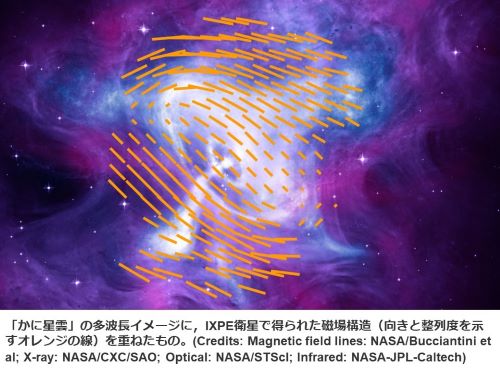Key points of this research results
- We observed the Crab Nebula with imaging polarimetry in X-rays for the first time
- We found that the distribution of the magnetic-field turbulence is highly asymmetric with respect to the pulsar rotation axis, contrary to expectations
- A filament and bipolar jets are likely to cause this magnetic field structure
Outline
The Crab Nebula is a famous astrophysical object consisting of a pulsar (PSR) and a pulsar wind nebula (PWN) powered by the PSR, and it originated from a supernova in 1054. Polarization measurements, particularly in X-rays, are key to understanding the magnetic-field structure of the PWN. IXPE (Imaging X-ray Polarimetry Explorer) performed the imaging-polarimetry of the Crab PWN in X-rays for the first time.
X-ray surface brightness of the Crab PWN has been known to be roughly symmetric with respect to the PSR spin axis, and the magnetic field structure has been expected to be symmetric as well. Nevertheless, we found that the spatial distribution of the polarization degree (anticorrelates with the turbulence of the magnetic field) was highly asymmetric. This intriguing magnetic field structure can be seen in the figure (where orange lines show the magnetic field direction and polarization degree).
We also carried out an in-depth analysis of the IXPE data. We found that a filamentary structure seen in optical (and X-ray absorption), as well as bipolar jets seen in X-ray images, are likely to change the magnetic field direction and hence produce the asymmetric distribution of the polarization. For details, please see Bucciantini et al. 2023 and Mizuno et al. 2023.

Paper Info
- Bucciantini, N., Mizuno, T., et al. 2023, Nature Astronomy 7, 602
- Mizuno, T., Ohno, H., Watanabe, E., Bucciantini, N., Gunji, S., Shibata, S., Plane, P., Weisskopf, M. C. 2023, PASJ 75, 1298

 Home
Home



